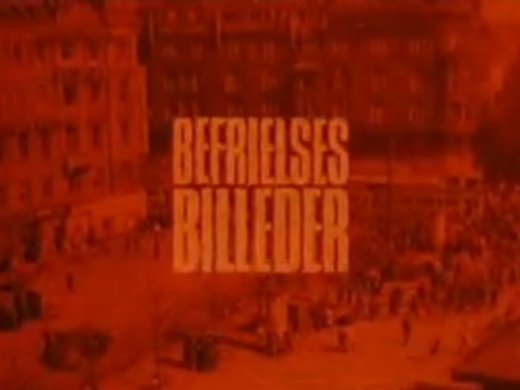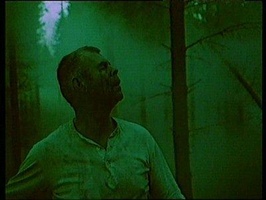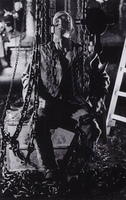It is a challenge* to find commentary online about Lars von Trier’s film school graduation piece, Befrielsesbilleder (translated as Image of Relief / Liberation Pictures/Photos or variants of these words). Without giving away too much of the plot—is there one?—I’ve attempted to collect as much information about the film that I could dig up. Take 57 minutes to go watch it on YouTube and then come back here to see if you can piece together this “film noir.”
“A film should be like a stone in your shoe.” – Lars von Trier (Source)

Synopsis: In this thought-provoking graduate film of student Lars von Trier, the behavior of Danish resistance fighters at the end of World War II is called into question by documentary footage of them making street arrests and by fictional enactments of crimes. In one sequence, a captive German officer escapes prison and is led into a trap in the forest by a Danish woman — she believes he was responsible for blinding a teenager, and she stabs his eyes through with a wooden blade. He is left to crawl in the very woods where as a child, he had tried to converse with the birds. Using both color and black-and-white to good advantage, the cinematography adds to the dramatic impact. – By Eleanor Mannikka on AllMovie

“Von Trier steals from the best” by Barry Neuman, NYC, sole IMDB review:
Von Triers graduation film is the work of a young director with a vision and a firm grip of his medium. Even though every other scene (or individual shot for that matter) has been lifted from Tarkovsky‘s films or Bertolucci‘s “The Conformist” the film has a gripping mood and qualities that cannot be ignored – the lesson of this must be: if you steal, steal from the best. Von Trier would later develop this style into his fascinating and original “Europa”, before he with “Breaking the Waves” abandoned all this for Cassavettes style hand held camera and more conventional, naturalistic performances. A pity.
“Lars Von Trier’s Europe Trilogy” by Noel Megahey, UK, on The Digital Fix. This is a thorough review of the Region 2 (non-USA) DVD set released in 2005. Images of a Relief is one of the many special features in the box set, including Nocturne, an 8-minute short from 1980. There is also a 2005 interview in the set where Lars makes a few comments about the film (A Conversation with Lars von Trier, 45min), currently available on YouTube.
Another hidden feature, Lars von Trier’s graduation film can be found behind the Alka-Seltzer in the Special Features menu. Images of a Relief (52:06) is made again with Tómas Gislason and Tom Elling, and bears all the hallmarks of Element of Crime and Europa, again heavily influenced by Tarkovsky and some of the elements reminding me of Bertolucci‘s The Conformist. The story – seeming to be based around the sufferings of a group of suicidal German troops at the hands of partisans at the end of the war, is almost incoherent. The picture quality here however is rather too murky for the chiaroscuro lighting. Still, it’s a very nice extra to complete a comprehensive package of Lars von Trier’s early work.
“The Films of Lars von Trier” by Tyler, New Zealand, on Southern Vision. This is from a blog entry reviewing the entire von Trier filmography (through 2012). There are currently 39 comments on the page:
This genuinely disturbing prisoners-of-war film is more of an experiment than anything else for Lars von Trier. Available as a DVD extra or via YouTube, the film is only an hour long and doesn’t really make any sense at first glance. The screen soaked in reds, yellows and greens, the strange film has a dark and grungy look but is only momentarily fascinating and often boring. However, in all fairness, it does have it’s moments and isn’t really all that bad. 6/10
“LARS VON TRIER” by Dennis Grunes. This is from a another blog entry reviewing the entire von Trier filmography, and updated since original blog post; I’ve included here only an excerpt from the seven-paragraph review of Images of Liberation:
Daringly original, it nonetheless evokes films the student loves: Charles Laughton’s Night of the Hunter (1955), Bernardo Bertolucci’s The Conformist (1970), Andrei Tarkovsky’s Mirror (1974), John Cassavetes’ Killing of a Chinese Bookie (1976). Imagine being a kid in film school and having your graduation effort win the best film prize at Munich!
“Befrielsesbilleder review” by tsar, UK, on Letterboxd (a social network for film reviews):
the conformist meets mirror meets the element of crime
this is von trier’s graduation film. the style of his very early work, no matter how overtly inspired, is, to me, a thing of extreme beauty and substance. the way he works with darkness, single colours, and intangible shapes, makes me want to break down.
the film’s story is political and personal. the accompanying images are immediately haunting.
i do not know where this side of von trier is now. i adore what he is doing now, but it is incredible to me that he seems to have been able to separate himself from whatever caused him to make this.
No reviews on Rotten Tomatoes. Limited information on Wikipedia. There is a review in Danish at Philm.
- Directed by Lars von Trier. Written by von Trier and Tom Elling, a film school collaborator who was also the director of photography for The Element of Crime. Edward Fleming (German officer Leo Mendel) and Kirsten Olesen (his mistress Esther) were the only professional actors in the film. More credits on IMDb.
- Graduation film for the National Film School of Denmark (Den Danske Filmskole) June 30, 1982
- Won ‘Channel Four Prize’ director (Denmark) 1982 Munich International Festival of Film Schools (Internationales Festival der Filmhochschulen München)
According to the Danish Film Institute, this was the first Danish student film to reach wide release. That link also has a gallery of 16 Befrielsesbilleder production stills (see purple-tinted photo below).



Bonus: Frequent Cast Appearances in von Trier Projects
- Udo Kier (10: Epidemic, Medea, Europa, Kingdom, Breaking, Dancer, Dogville, Manderlay, Melancholia, Nymphomaniac)
- Stellan Skarsgård (8: Breaking, Kingdom, D-Dag, Dancer, Dogville, Dimension, Melancholia, Nymphomaniac)
- Lars von Trier (8: Nocturne, Element, Epidemic, Europa, Kingdom, Idiots, Five, Boss)
- Jean-Marc Barr (7: Europa, Breaking, Dancer, Dogville, Manderlay, Boss, Nymphomaniac)
- Charlotte Gainsboro (3: Antichrist, Melancholia, Nymphomaniac)
- Willem Dafoe (3: Manderlay, Antichrist, Nymphomaniac)
- Solbjørg Højfeldt (2: Nocturne, Medea)
- Kirsten Olesen (2: Images, Medea)
Here is a detailed spreadsheet of all of his films:
* In fact, most of this renowned Danish director’s films before Dogville are very difficult to purchase in America. Some may be found on YouTube from time to time, but the video quality is usually horrendous. Tartan really needs to release the Europa trilogy DVD set (mentioned above) to Region 1.